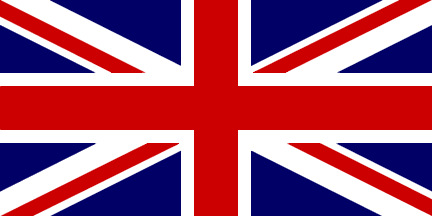Union Jack
Union Jack or Union Flag?
 Union Jack or Union Flag? Whatever you prefer, but did you know that the Union Jack is 400 years old? Yep, the Union Flag celebrates 400 years of being the visual representation of all things British on 12th April 2006.
Union Jack or Union Flag? Whatever you prefer, but did you know that the Union Jack is 400 years old? Yep, the Union Flag celebrates 400 years of being the visual representation of all things British on 12th April 2006.According to HM The Queen's website, (so who am I to argue?) The Union Flag, or Union Jack is so called because it combines the emblems of the three countries united under one Sovereign - the kingdoms of England and Wales, of Scotland and of Ireland (although since 1921 only Northern Ireland has been part of the United Kingdom).
The term Union Jack possibly dates from Queen Anne's time (reigned 1702-14), but its origin is uncertain. It may come from the 'jack-et' of the English or Scottish soldiers; or from the name of James I who originated the first union in 1603, in either its Latin or French form Jacobus or Jacques; or, as 'jack' once meant small, the name may be derived from a royal proclamation issued by Charles II that the Union Flag should be flown only by ships of the Royal Navy as a jack, a small flag at the bowsprit.
The flag consists of three heraldic crosses.
The cross of St George, patron saint of England since the 1270's, is a red cross on a white ground. After James I succeeded to the throne, it was combined with the cross of St. Andrew in 1606.
The cross saltire of St Andrew, patron saint of Scotland, is a diagonal white cross on a blue ground.
The cross saltire of St Patrick, patron saint of Ireland, is a diagonal red cross on a white ground. This was combined with the previous Union Flag of St George and St Andrew, after the Act of Union of Ireland with England (and Wales) and Scotland on 1 January 1801, to create the Union Flag that has been flown ever since.
The Welsh dragon does not appear on the Union Flag. This is because when the first Union Flag was created in 1606, the Principality of Wales by that time was already united with England and was no longer a separate principality.
According to United Kingdom - History of the Flag, when King James VI of Scotland ascended to the English throne, thereby becoming James I of England, the national flags of England and Scotland on land continued to be, respectively, the red St George's cross and the white St Andrew's cross. Confusion arose, however, as to what flag would be appropriate at sea. On 12 April 1606 a proclamation was issued:
"All our subjects in this our isle and kingdom of Great Britain and the members thereof, shall bear in their main top the red cross commonly called St George's Cross and the white cross commonly called St. Andrew's Cross joined together according to a form made by our heralds and sent to our Admiral to be published to our said subjects."
This is the first known reference to the Union Flag. Although the original design referred to has been lost, it is presumed that it was the flag which, with the addition of the St Patrick's cross, forms the basic design of the British Union Flag today.
So let's wait and see, maybe tomorrow this fantastic anniversary will be splashed across the front pages of all newspapers. Maybe I'll be surprised at our nation's newspapers new found patriotism. Or perhaps as I expect, this 400th birthday will go by unmarked.
I'm ashamed sometimes at my lack of knowledge of our great nation's history, if you feel the same way, why not check out The Pocket Book of Patriotism
George Courtauld the author of The Pocket Book of Patriotism
The article concludes : The flag under which all our gallant Welsh, Irish, Scottish and English servicemen and women are laid to rest. The flag that symbolises our ancient freedoms and traditions; the Crown in Parliament, trial by jury, habeas corpus, the presumption of innocence and freedom of speech, our defence of the weak and our defiance of the mighty. The flag of those who have gone before and those yet to come. The flag of glory and the flag of hope.






0 Comments:
Post a Comment
<< Home